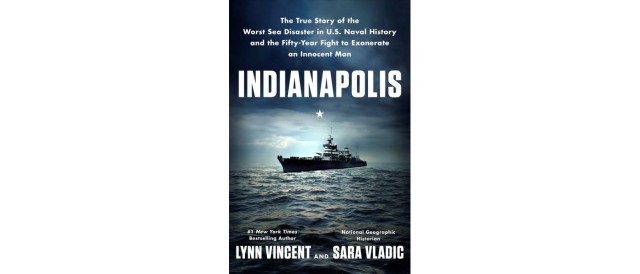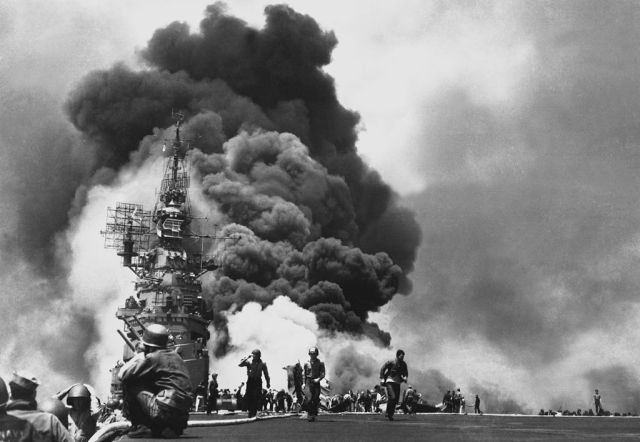
USS O’Bannon (DD-450) moored in mid-1942. Wartime censors re-touched the image to remove her radar and Mark 37 gun director. She’s painted in Camouflage Measure 12 (modified). National Archives Photograph. 80-G-44177.
Seventy-five years ago today, on 5 April 1943, USS O’Bannon (DD-450), the legendary WWII destroyer, sank Japanese submarine RO-34 using a well-placed shot-and potatoes. Among the many sea stories of the US Navy throughout our nations history, the sinking of an enemy submarine from potatoes has become legendary. It sounds like something only Superman or Captain America could pull off, except in this case, what happened that day 75 years ago actually did occur. Minus the potatoes.
On 4 April 1943, several U.S. destroyers of Destroyer Squadron Twenty-One (DesRon 21) had shelled enemy shore installations on New Georgia. Among those destroyers were the USS Strong (DD-467), USS Taylor (DD-468), USS Nicholas (DD-449), USS Radford (DD-446), USS Jenkins (DD-447), and O’Bannon. All were steaming back towards their base at Tulagi Harbor after the mission, when at 0225 on the morning of 5 April 1943, O’Bannon proceeded to investigate a radar contact with Strong standing by to assist.
O’Bannon’s skipper, Cmdr. Donald J. MacDonald, received word from his radarmen of an enemy submarine running on the surface at 7,000 yards. He brought O’Bannon close enough to the enemy submarine that his lookout, the ship’s cook, from his watchstanding station on deck, later told his captain that he thought he could have thrown potatoes at the boat.

Commander Donald J. MacDonald, Commanding Officer of USS O’Bannon (DD-450), received two awards of the Navy Cross, three Silver Stars, two Legions of Merit and two Bronze Star awards during the war. (National Archives Photograph. 80-G-44101-A).
The legend holds that MacDonald prepared to ram RO-34, but suddenly worried at the last second the sub may have been in the middle of mine-laying operations. Fearing this would needlessly put his ship and crew in harm’s way, he ordered hard rudder left. Suddenly, O’Bannon was steaming parallel with the Japanese submarine. The American crew saw right away that the Japanese submariners were all asleep out on deck, but were unable to lower and fire their larger caliber guns at the sub, and did not carry small arms with them. The Japanese, finally waking up to Americans staring in amazement and curiosity at them, also had no weapons on hand. However, they did have a 3-inch deck gun that could fire upon the O’Bannon, and quickly made a run to reach it. In a newspaper article written some 40 years after the incident, some of O’Bannon’s veterans claimed the ship was able to fire “once” (they don’t say from which gun), took out the sub’s conning tower, and then found bins full of potatoes (why they’d be on the main deck and not on the galley deck is unknown) and began throwing them at RO-34, incredibly only “50 feet away”(!)
The Japanese, believing the potatoes to be either hand grenades, or having an irrational fear of vegetables, threw them overboard or back at the sailors on O’Bannon. But the sudden and inspired food fight worked. The Japanese were so distracted by the potato assault that every single one of them stopped running towards, or was unable to reach the 3-inch deck gun, and O’Bannon was able to pull away and then proceed to sink RO-34.
So what really happened?
MacDonald was a fighting captain (and an extremely highly decorated one to prove it). He immediately went into action. Attacking RO-34, he dropped three depth charges and also ordered his 20-millimeter and 40-millimeter gun crews to open fire. The depth charges straddled RO-34, while 16 rounds from the 20mm and 40mm guns struck her conning tower. O’Bannon came around for a second pass and dropped more depth charges while firing again from both of her 20mm and 40mm guns. RO-34 began to sink by her stern. By the time O’Bannon circled around and came in for her third attack, she reported the target “blew up as a result of firing.” The crew on deck watched as RO-34 jumped out of the water and was slammed down again, settling by her stern moments before feeling a violent explosion underwater.

View of ship’s after 20-millimeter battery, on the fantail, while at sea, c.1943.
(National Archives Photograph. 80-G-K-3975).
At 0250, she reported to the task group that the enemy vessel was still on the surface and damaged but “unable to dive.” Cmdr. MacDonald later wrote: “This contact may be considered a destroyer officer’s dream…First there were radar contacts, then sight contact, then the submarine was hit and remained dead in the water while the O’Bannon came in close enough to throw depth charges at her and finally send her to the bottom.” RO-34 sank shortly after with all 66 hands. Already by 1943, O’Bannon’s crew, under MacDonald became legendary fighters, never losing a single man during the war. Their skipper recalled, “All I had to do was say, ‘Commence firing!’ and they put on a wonderful show.”
When daylight finally arrived on 5 April, pilots reported a thick oil slick, as well as debris from the location, giving O’Bannon credit for a probable sinking of the submarine. However, the American press quickly picked up the story, and printed it as the epic tale of an American destroyer that attacked an enemy submarine by throwing potatoes at surprised Japanese sailors standing around on their ship. O’Bannon even received a plaque from a group called the Maine Potato Growers, to honor the occasion. The tall tale began taking on such a huge life of its own that even some of O’Bannon’s own former crewmen began telling and re-telling it to audiences, making it more difficult to disprove. But long after the war, MacDonald himself admitted, “I’ve been trying to drive a stake through this story for years.” He agreed that he maneuvered O’Bannon close to RO-34, but explained that even the crewmember with the best throwing arm could not have tossed a potato or anything else across the gap. “From that single remark [of the cook] has grown the entire legend of the use of Maine potatoes to sink a Japanese submarine.”

Commander Donald J. MacDonald, CO, USS O’Bannon (DD-450) (left), and Captain Thomas J. Ryan, CO, Destroyer Division Twenty-One (DesRon 21) (right). Commander MacDonald received the Navy Cross on board his ship on 22 August 1943. Captain Ryan presented the award. (Official U.S. Navy Photograph, now in the collections of the National Archives. 80-G-56139).
Bibliography:
Colleen Johnson, “This Spud’s For You: Shipmates Recall Holding off Japanese Sub,” The Pittsburgh Press, July 14, 1984.
John Sherwood, “The Legend of the Deadly Potatoes,” Washington Times, April 17, 1974.
John Wukovits, Tin Can Titans: The Heroic Men and Ships of World War II’s Most Decorated Navy Destroyer Squadron (Boston: Da Capo Press, 2017), 132.
USS O’Bannon (DD-450) War Diary, Monthly War Diary, June 1942 to October 1945














 Pacific War Color Images
Pacific War Color Images